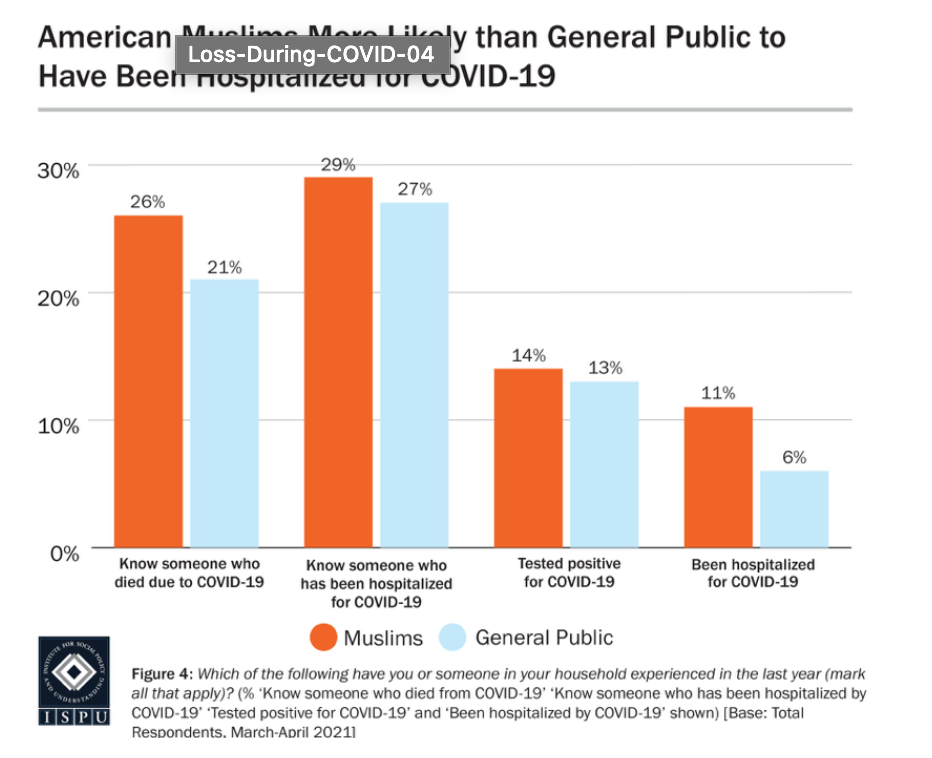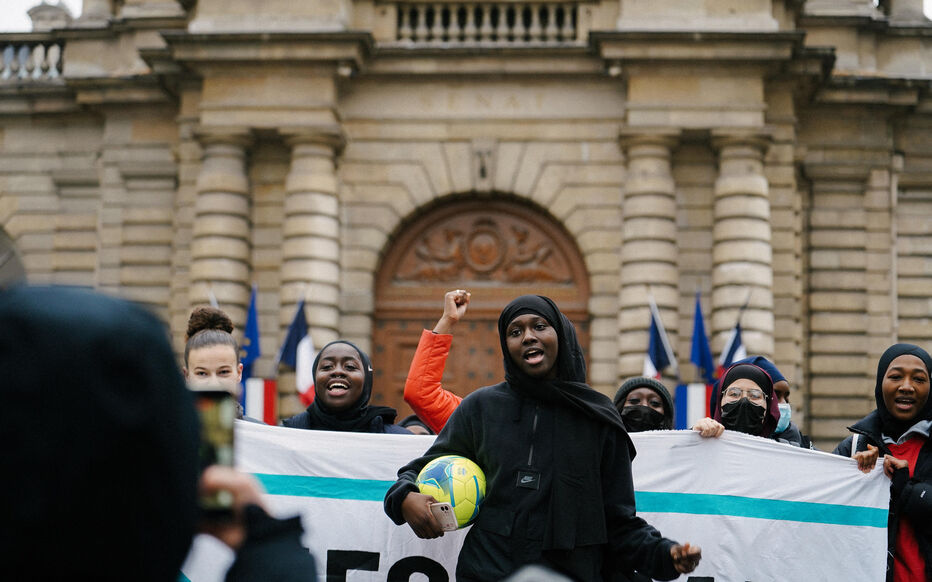Whilst many people in the U.S and UK have experienced considerable financial, health, and personal losses as a direct consequence of Covid-19, Muslim communities in particular have been disproportionately disadvantaged and negatively impacted by the pandemic1,2.
A report published by the US based think-tank (Institute for Social Policy) in February 2022, titled “Loss of Many Kinds: Financial and Health Impacts of Covid-19 on American Muslims”, emphasizes two specific characteristics that put American Muslims at an additional disadvantage with the challenges posed by Covid-19. Firstly, Muslims are the most ethnically diverse faith group in the US3, with 28% of the US Muslim population identifying as Black or African American according to ISPU research4. Further research by the CDC (Centre for Disease Control and Prevention) has shown that Covid-19 has brought social and racial injustice and structural inequality to the front of public health5, and Black communities in particular, were disproportionately impacted by the pandemic.
Secondly, a third of Muslim families in the US report having a low income (households living on, or below the poverty line) which is larger than any other US faith community6. This statistic emerged from previous ISPU research conducted in 2018. In their report “What’s the Hidden Story Behind American Muslim Poverty” the ISPU looked in more depth at their 2018 American Muslim poll. They show how, despite American Muslims faring better socioeconomically than other minority Muslim populations around the globe, and 18% of American Muslims reporting a household income above $100,000 (compared to 31% of Americans generally), 33% of Muslims make less than $30,000 compared to 24% of the general population, which is at a level at or below the poverty line7. With the American Muslim population being so diverse, the ISPU examined demographic factors and in controlling for household size, race/ethnicity and geographic region, they found Black Muslim households were significantly more likely than any other Muslim racial group to earn less than $30,000 per year and Arab households were more likely to report incomes over $75,000 per year8.
The report “Together in Tribulation: British Muslims and the Covid-19 Pandemic” published in November 2020 by the Muslim Council of Britain (MCB), in collaboration with the British Islamic Medical Association, found similar socio-economic reasons for the higher negative impact of COVID on Muslims than on other faith groups. The starkest way Muslim communities were hit by the pandemic was in terms of mortality. According to the data of Public Health England, Black and Ethnic groups reflected the highest age-standardised diagnosis rated of Covid-19 per 100,000 cases, whilst their white counterparts reflected the lowest9. The MCB went onto argue that given approximately 90% of British Muslims are from black and ethnic minority backgrounds, even without data, “it was logically assumed that Muslim communities were also being disproportionately impacted”10.
Report Methodologies
The findings published by the ISPU reflect the experiences of American Muslims a year into the COVID-19 pandemic. A questionnaire was developed by ISPU and was commissioned by Qualtrics (an online survey tool). This survey was fielded by Qualtrics to a “non-probability, nationally representative online sample of self-identified American Muslims and of the American General Public”11 from March 22nd to April 8th, 2021. A total of 1,648 surveys were completed, with 825 American Muslims and 823 of the general American public completing the survey. These findings were then analysed by researchers at the ISPU where comparisons were made among gender, age, and racial groups. It is also specified that within the racial groups sampling, comparisons were made between Black, Arab, and Asian Muslims, and between Black and Hispanic Americans for the general public samples12.
The report by the MCB however, relies on secondary data from previously published research. Specifically related to financial and health impacts of covid-19 on Muslim Communities, the MCB draw on data from sources such as the MCB’s previous report “British Muslims in Number 2015”, Public Health England’s “Beyond the data: Understanding the impact of COVID-19 on BAME groups” (2020), and the ONS (Office for National Statistics provisional) analysis detailing “Coronavirus (Covid-19) related deaths by religious group” (2020) and “Deaths involving COVID-19 by local area and socioeconomic deprivation” (2020).
Health Implications
U.S Findings
According to the ISPU, exposure to COVID-19 was higher amongst the Muslim population than the general public. As the figure below shows, 26% of Muslims know someone who died of Covid-19, which is slightly higher than 21% of the general public. US Muslims also had a significantly higher rate of hospitalisations (11%) in comparison to the general population (6%). However, similar rates between Muslim communities and the general population were reported when looking at those who have tested positive and knowing someone who has been hospitalised for covid-19, as demonstrated in the figure below.

In their analysis, the ISPU further broke down these statistics based on age and racial groups. Concerning racial groups, they found that Arab Muslims (20%) and Black Muslims (16%) were more likely than Asian Muslims (11%) and white Muslims (9%) to test positive for Covid-1913. They also reported that Arab Muslims (37%) were significantly more likely to know someone who died of Covid-19 compared to Asian (22%), Black (25%), and white (20%) Muslims14.
Breaking these statistics down further by gender revealed that Muslim women in the US were more likely than Men to test positive for Covid-19 (18% vs 10%) and more likely than men to know someone who has died as a result of covid-19 (32% vs 21%). However, whilst more women tested positive according to the survey, more Muslim men were hospitalised (14% for men vs 8% for women)15.
Age also had a significant impact on the survey results. The ISPU reported that Young Muslims (aged 18-29) were 7% more likely to test positive for Covid-19 than other age groups16. This is not due to poor masking, but their living circumstances as nearly half (48%) of Young Muslims live with their parents or extended family, compared to 9% of 30-49 year olds, and 4% of those aged 50+17.
UK Findings
The MCB drew on findings reported in June 2020 by the Office for National Statistics (ONS) who published provisional analysis on Covid-19 according to religious affiliation. This data was based on death registrations up to the 29th May 2020 and confirmed that Muslim communities in the UK had the highest mortality rate for Covid-19, with 198.9 deaths per 100,000 males and 98.2 deaths per 100,000 females18. In comparison to their Christian counterparts, Muslim women were 1.9 times more at risk of dying from Covid-19 and Muslim men 2.5 more at risk. The MCB argues that the reason the Muslim community is significantly more at risk of dying of Covid-19 is due to long-standing, pre-existing inequalities that already affected BAME and Muslim communities before the pandemic. When looking at socio-economic deprivation and exposure, the MCB draws on data showing that covid-19 has a proportionally higher impact on those who live in more deprived areas of the UK19. 46% of British Muslims currently live in the ten most deprived areas of the UK too, putting them more at risk20.
Like findings from the ISPU survey, the intergenerational nature of Muslim and BAME households can play a contributing factor. However, the MCB also reported specific Housing Challenges in the UK to increase the risk of covid-19 amongst Muslim communities. Drawing on the UK 2011 census they show how 35% of Muslim households compared to 13% of the general population are overcrowded, lack at least one bedroom, have no central heating and have to share a kitchen and bathroom21. Breaking this down by ethnic groups, the MCB also reveal that Black Africans (43%) and Bangladeshis (42%) experience the highest household disadvantage, and Muslims within these ethnic groups experience higher levels of housing disadvantage in comparison to other religious groups22. These housing conditions make it challenging for people to self-isolate and maintain social distancing, making other members of the household more susceptible to contracting covid-19.
Financial Implications
U.S Findings
According to the ISPU, one year into the Covid-19 pandemic, 27% of American Muslims in comparison to 19% of the general public reported losing their jobs23. 24% of US Muslims also reported having had their working hours or pay cut due to covid-19, 3% more than the general population. When breaking these statistics down by race, the IPSU survey shows that among American Muslims, Arab Muslims (27%) were most likely to have their hours or pay cut due to the pandemic, in comparison to Asian (18%), Black (20%), and white (23%) Muslims24. However, when looking at job loss, statistics show that white muslims (31%) were significantly more likely than the general US population (14%) to lose their job during the pandemic, and more likely than Black Muslims (22%)25.
UK Findings
When looking at job loss within UK Muslim and BAME communities, the MCB draw on findings published by the Institute of Social and Economic Research which show that BAME communities were more likely than their white counterparts to lose their jobs instead of being placed on the UK furlough scheme26. By May 2020, 4,000 workers in the UK had lost their job, 21% of these were from ethnic minorities compared to 7% who were white27. The study also reveals that high numbers of ethnic minorities lost their jobs on account of working in insecure employment sectors and being self-employed. Looking into types of jobs that BAME workers have, the Runnymede Trust have reported that 25% have zero hour “gig-economy” jobs, where their income is not guaranteed and are not eligibly to benefit from the UK Government’s energy support financial packages. This is 9% higher than the general population in the UK28.
Sources
https://www.cdc.gov/coronavirus/2019-ncov/community/health-equity/race-ethnicity.html
https://www.ispu.org/loss-during-covid/
https://www.ispu.org/whats-the-hidden-story-behind-american-muslim-poverty/
https://www.mcb.org.uk/wp-content/uploads/2015/02/MCBCensusReport_2015.pdf






